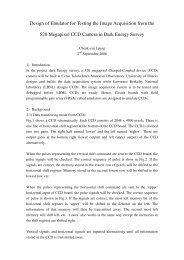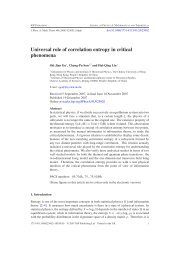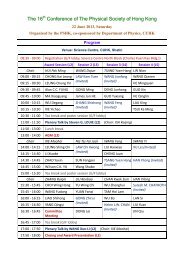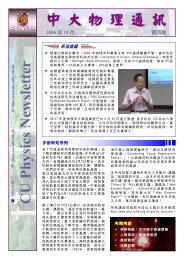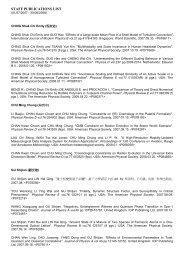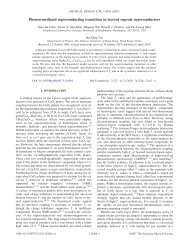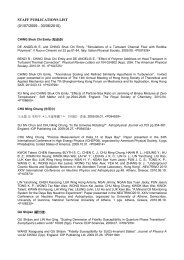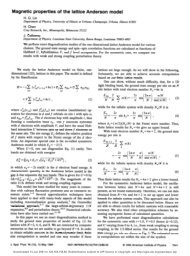19th Issue (Oct-2012) - Department of Physics - The Chinese ...
19th Issue (Oct-2012) - Department of Physics - The Chinese ...
19th Issue (Oct-2012) - Department of Physics - The Chinese ...
Create successful ePaper yourself
Turn your PDF publications into a flip-book with our unique Google optimized e-Paper software.
C. N. Yang<br />
Int. J. Mod. Phys. A <strong>2012</strong>.27. Downloaded from www.worldscientific.com<br />
by THE CHINESE UNIVERSITY OF HONG KONG on 10/09/12. For personal use only.<br />
Institute, J. M. Luttinger and I happened to talk about the Ising model.<br />
Luttinger said that Bruria Kaufman had simplified Onsager’s method<br />
so that the solution could be understood in terms <strong>of</strong> the representation<br />
<strong>of</strong> a system <strong>of</strong> 2n anticommuting Hermitian matrices. I knew such representations<br />
well and understood quite readily the main points <strong>of</strong> the<br />
Onsager–Kaufman method. After arriving at the Institute, I worked out<br />
the essential steps <strong>of</strong> this approach and was very happy at finally understanding<br />
Onsager’s solution ...<br />
I kept thinking about it, and realized that Onsager and Kaufman had<br />
obtained much more information than just the partition function ,...<br />
I was thus led to a long calculation, the longest in my career. Full <strong>of</strong><br />
local, tactical tricks, the calculation proceeded by twists and turns. <strong>The</strong>re<br />
were many obstrctions. But always, after a few days, a new trick was somehow<br />
found that pointed to a new path. <strong>The</strong> trouble was that I soon felt<br />
I was in a maze and was not sure whether in fact, after so many turns, I<br />
was anywhere nearer the goal than when I began. This kind <strong>of</strong> strategic<br />
overview was very depressing, and several times I almost gave up. But each<br />
time something drew me back, usually a new tactical trick that brightened<br />
the scene, even though only locally.<br />
Finally, after about six months <strong>of</strong> work <strong>of</strong>f and on, all the pieces suddenly<br />
fitted together, producing miraculous cancellation, and I was staring<br />
at the amazingly simple final result.<br />
Why was I able to “understood quite readily the main points <strong>of</strong> the Onsager–<br />
Kaufman method”? One: I had thoroughly studied the representation <strong>of</strong> 2n anticommuting<br />
Hermitian matrices when I studied Dirac’s equation in Kunming. Two:<br />
I had spent several weeks in 1947 in Chicago trying to understand Onsager’s 1944<br />
paper, without success. But that experience had thoroughly familiarized me with<br />
Onsager’s paper. Combining these two earlier efforts I was able to rapidly understand<br />
what Luttinger had said about the real strategy <strong>of</strong> Onsager’s solution.<br />
What I had learned from Pr<strong>of</strong>essor J. S. Wang in Kunming made me deeply<br />
interested in statistical mechanics, leading to my preparatory efforts in Chicago<br />
on Onsager’s work. <strong>The</strong> final breakthrough came from a short conversation with<br />
Luttinger. This process:<br />
Interest → Preparation → Breakthrough, (5)<br />
I think, is the necessary three-step process for any research work. In the experience<br />
described above the breakthrough came from an external stimulation (conversation<br />
with Luttinger). But in most cases the breakthrough is a sudden inspiration without<br />
external stimulation: After long preparation, when one is not thinking about<br />
the problem, apparently new conceptual combinations were still being formed subconsciously<br />
in one’s brain. When the right combination occurs a sudden inspiration<br />
would result. A century earlier Poincaré 8 had given a very interesting analysis <strong>of</strong><br />
this process.<br />
1230009-10



